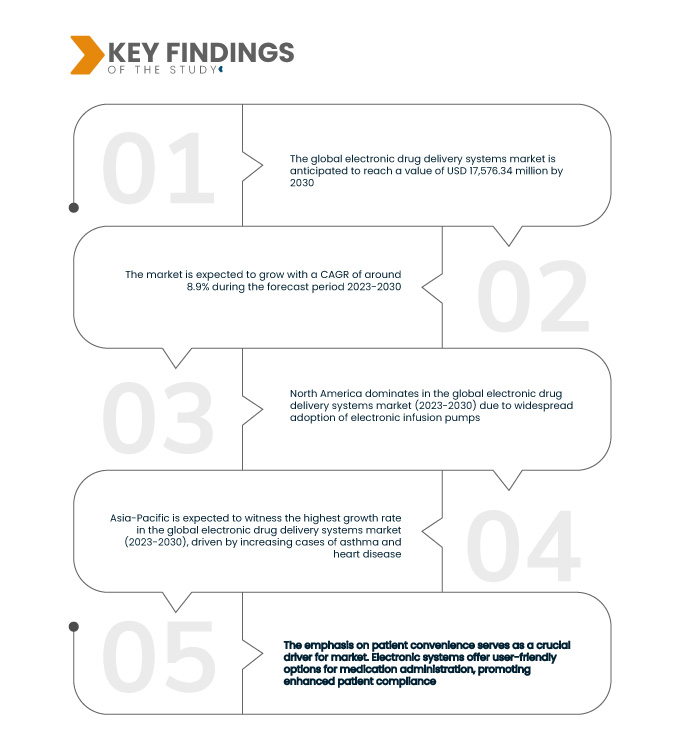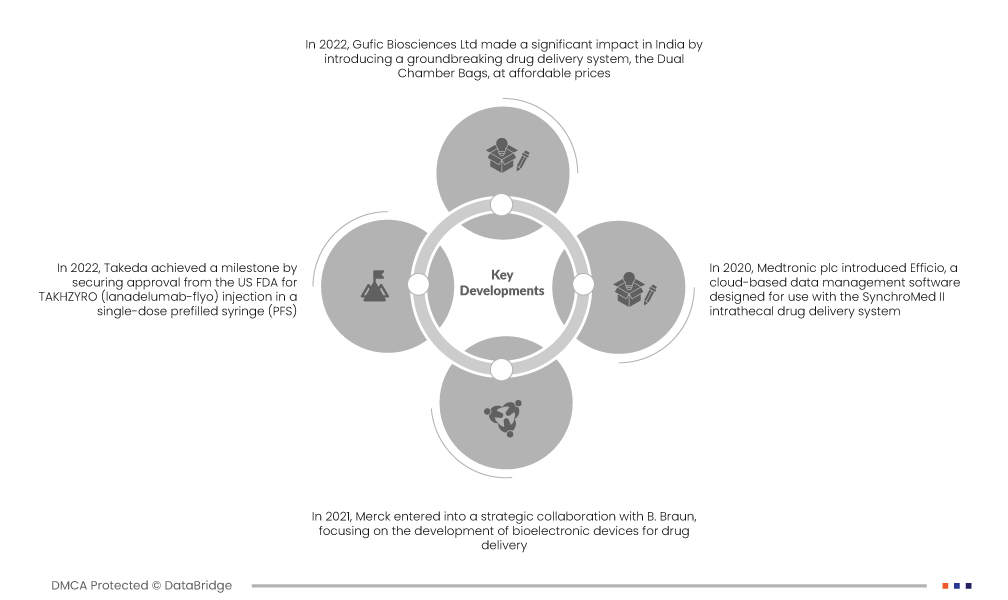Elektronische Arzneimittelverabreichungssysteme gewährleisten eine präzise und kontrollierte Verabreichung von Medikamenten. Diese innovativen Systeme steigern die Wirksamkeit der Behandlung, verbessern die Therapietreue der Patienten und ermöglichen personalisierte Dosierungsschemata. Mit Funktionen wie automatisierter Verabreichung und Echtzeitüberwachung liefern sie medizinischem Fachpersonal wertvolle Erkenntnisse und ermöglichen ein besseres Krankheitsmanagement. Sie tragen zu besseren Patientenergebnissen bei und machen die Medikamentenverabreichung präziser, komfortabler und individueller.
Vollständigen Bericht finden Sie unter https://www.databridgemarketresearch.com/reports/global-electronic-drug-delivery-systems-market
Data Bridge Market Research analysiert den globalen Markt für elektronische Arzneimittelverabreichungssysteme , der im Jahr 2022 ein Volumen von 16.139,89 Millionen US-Dollar erreichte, bis 2030 voraussichtlich auf 17.576,34 Millionen US-Dollar anwachsen und im Prognosezeitraum 2023–2030 eine durchschnittliche jährliche Wachstumsrate (CAGR) von 8,9 % verzeichnen wird. Der rasante Fortschritt in der Mikrotechnologie ist ein wichtiger Markttreiber. Dieser Fortschritt ermöglicht die Entwicklung hochentwickelter Geräte, die eine präzise Dosierungskontrolle, Verbrauchsüberwachung und nahtlose Konnektivität mit Gesundheitsdienstleistern über mobile Apps und Cloud-Plattformen ermöglichen.
Wichtigste Ergebnisse der Studie
Es wird erwartet, dass die Zunahme chronischer Krankheiten das Marktwachstum ankurbelt
Der Markt für elektronische Arzneimittelverabreichungssysteme wird durch die zunehmende Belastung chronischer Krankheiten wie Diabetes, Herz-Kreislauf-Erkrankungen und Atemwegserkrankungen vorangetrieben. Dieser Anstieg der Prävalenz führt zu einer Nachfrage nach fortschrittlichen Arzneimittelverabreichungssystemen, die eine kontinuierliche Überwachung und präzise Medikamentenverabreichung ermöglichen. Elektronische Geräte wie intelligente Pumpen und tragbare Technologien ermöglichen die Echtzeitüberwachung der Gesundheitsdaten von Patienten und erleichtern die gezielte Medikamentenverabreichung. Der Markt wird durch den Bedarf an innovativen Lösungen angetrieben, die die Komplexität chronischer Krankheiten berücksichtigen und Patienten effektivere und personalisierte Therapien ermöglichen.
Berichtsumfang und Marktsegmentierung
Berichtsmetrik
|
Details
|
Prognosezeitraum
|
2023 bis 2030
|
Basisjahr
|
2022
|
Historische Jahre
|
2021 (Anpassbar auf 2015–2020)
|
Quantitative Einheiten
|
Umsatz in Millionen USD, Mengen in Einheiten, Preise in USD
|
Abgedeckte Segmente
|
Typ (Elektronische Infusionspumpen, Elektronische Injektionspens, Elektronische Autoinjektoren, Elektronische Inhalatoren, Elektronische Kapseln, Sonstiges), Komponente ( Sensoren , Drahtlose Kommunikationsgeräte und Antennen , Mikropumpen und Durchflussregler, Medikamentenbehälter, Mikrocontroller, Sonstiges), Konnektivität (Bluetooth Low Energy (BLE), Wi-Fi, Ethernet, NB-IoT, Sonstiges), Systemtyp (Batteriebetriebene Systeme, Wiederaufladbare Systeme), Anwendung (Diabetes, Asthma und chronisch obstruktive Lungenerkrankung (COPD), Multiple Sklerose , Wachstumshormontherapie, Immunschwächekrankheit, Herz-Kreislauf-Erkrankungen, Thalassämie, Sonstiges), Endbenutzer (häusliche Gesundheitsversorgung, Krankenhäuser, Kliniken, Ambulanzen, Sonstiges)
|
Abgedeckte Länder
|
USA, Kanada, Mexiko, Deutschland, Italien, Großbritannien, Frankreich, Spanien, Niederlande, Belgien, Schweiz, Türkei, Russland, Restliches Europa, Japan, China, Indien, Südkorea, Australien, Singapur, Malaysia, Thailand, Indonesien, Philippinen, Restlicher Asien-Pazifik-Raum, Brasilien, Argentinien, Restliches Südamerika, Südafrika, Saudi-Arabien, Vereinigte Arabische Emirate, Ägypten, Israel, Restlicher Naher Osten und Afrika
|
Abgedeckte Marktteilnehmer
|
AstraZeneca (Großbritannien), Amgen Inc. (USA), Ypsomed AG (Schweiz), Merck KGaA (USA), Bayer AG (Deutschland), Nemera (Frankreich), F. Hoffmann-La Roche Ltd (Schweiz), Teva Pharmaceuticals USA, Inc. (USA), AptarGroup, Inc. (USA), Novo Nordisk A/S. (Dänemark), ViCentra BV (Niederlande), Medtronic (USA), United Therapeutics Corporation (USA), Companion Medical (USA), Tandem Diabetes Care, Inc. (USA), Debiotech SA (Schweiz), Canè SpA (Italien), Insulet Corporation (USA), BD (USA) und B. Braun Melsungen AG (Deutschland)
|
Im Bericht behandelte Datenpunkte
|
Neben den Einblicken in Marktszenarien wie Marktwert, Wachstumsrate, Segmentierung, geografische Abdeckung und wichtige Akteure umfassen die von Data Bridge Market Research kuratierten Marktberichte auch eingehende Expertenanalysen, Patientenepidemiologie, Pipeline-Analysen, Preisanalysen und regulatorische Rahmenbedingungen.
|
Segmentanalyse:
Der globale Markt für elektronische Arzneimittelverabreichungssysteme ist nach Typ, Komponente, Konnektivität, Systemtyp, Anwendung und Endbenutzer segmentiert.
- Der globale Markt für elektronische Arzneimittelverabreichungssysteme ist nach Typ in elektronische Infusionspumpen, elektronische Injektionspens, elektronische Autoinjektoren, elektronische Inhalatoren, elektronische Kapseln und andere unterteilt.
- Auf der Grundlage der Komponenten ist der globale Markt für elektronische Arzneimittelabgabesysteme in Sensoren, drahtlose Kommunikatoren und Antennen, Mikropumpen und Durchflussregler, Arzneimittelreservoirs, Mikrocontroller und andere unterteilt
- Auf der Grundlage der Konnektivität ist der globale Markt für elektronische Arzneimittelabgabesysteme in Bluetooth Low Energy (BLE), Wi-Fi, Ethernet, Nb-IoT und andere unterteilt.
- Auf der Grundlage des Systemtyps ist der globale Markt für elektronische Arzneimittelabgabesysteme in batteriebetriebene Systeme und wiederaufladbare Systeme unterteilt
- Auf der Grundlage der Anwendung ist der globale Markt für elektronische Arzneimittelabgabesysteme in Diabetes, Asthma und chronisch obstruktive Lungenerkrankung (COPD), Multiple Sklerose, Wachstumshormontherapie, Immunschwächekrankheit, Herz-Kreislauf-Erkrankungen, Thalassämie und andere unterteilt
- Auf der Grundlage des Endbenutzers ist der globale Markt für elektronische Arzneimittelabgabesysteme in häusliche Gesundheitspflege, Krankenhäuser, Kliniken, ambulante Zentren und andere unterteilt
Hauptakteure
Data Bridge Market Research erkennt die folgenden Unternehmen als die wichtigsten globalen Akteure auf dem Markt für elektronische Arzneimittelverabreichungssysteme an: AstraZeneca (Großbritannien), Amgen Inc. (USA), Ypsomed AG (Schweiz), Merck KGaA (USA), Bayer AG (Deutschland), Nemera (Frankreich), F. Hoffmann-La Roche Ltd (Schweiz), Teva Pharmaceuticals USA, Inc. (USA), AptarGroup, Inc. (USA)
Marktentwicklungen
- Im Jahr 2022 erzielte Gufic Biosciences Ltd. in Indien mit der Einführung eines bahnbrechenden Arzneimittelverabreichungssystems, den Dual Chamber Bags, zu erschwinglichen Preisen einen bedeutenden Beitrag. Dieser Schritt markierte einen wichtigen Schritt zur Verbesserung des Zugangs zu fortschrittlichen medizinischen Technologien im Land.
- Im Jahr 2022 erreichte Takeda einen Meilenstein mit der Zulassung der US-amerikanischen FDA für TAKHZYRO (Lanadelumab-Flyo) als Injektionslösung in einer Einzeldosis-Fertigspritze (PFS). Diese Zulassung unterstreicht die Wirksamkeit des Medikaments bei der Vorbeugung von Anfällen des hereditären Angioödems (HAE) und bietet eine praktische und benutzerfreundliche Lösung für erwachsene und pädiatrische Patienten ab 12 Jahren.
- Im Jahr 2021 ging Merck eine strategische Zusammenarbeit mit B. Braun ein, die sich auf die Entwicklung bioelektronischer Systeme zur Arzneimittelverabreichung konzentriert. Diese Zusammenarbeit unterstreicht das Engagement des Unternehmens, innovative Lösungen in der Arzneimittelverabreichung voranzutreiben und so die Verabreichung und das Management von Medikamenten zu revolutionieren.
- Im Jahr 2020 führte Medtronic plc Efficio ein, eine cloudbasierte Datenmanagement-Software für das intrathekale Medikamentenverabreichungssystem SynchroMed II. Ziel dieser Entwicklung war es, die Effizienz von Ärzten bei der gezielten Medikamentenverabreichung mit Pumpen zu steigern, insbesondere bei Patienten mit chronischen Schmerzen, Krebsschmerzen und schwerer Spastik.
Regionale Analyse
Geografisch betrachtet sind die im globalen Marktbericht für elektronische Arzneimittelverabreichungssysteme abgedeckten Länder die USA, Kanada, Mexiko, Deutschland, Italien, Großbritannien, Frankreich, Spanien, die Niederlande, Belgien, die Schweiz, die Türkei, Russland, das übrige Europa, Japan, China, Indien, Südkorea, Australien, Singapur, Malaysia, Thailand, Indonesien, die Philippinen, der übrige asiatisch-pazifische Raum, Brasilien, Argentinien, der übrige Teil Südamerikas, Südafrika, Saudi-Arabien, die Vereinigten Arabischen Emirate, Ägypten, Israel sowie der übrige Nahe Osten und Afrika
Laut Marktforschungsanalyse von Data Bridge:
Nordamerika ist die dominierende Region im globalen Markt für elektronische Arzneimittelabgabesysteme im Prognosezeitraum 2023-2030
Nordamerika dominiert den globalen Markt für elektronische Arzneimittelverabreichungssysteme aufgrund der weit verbreiteten Nutzung elektronischer Infusionspumpen in der Region. Die Nutzung elektronischer Infusionspumpen, Geräte zur präzisen Verabreichung von Flüssigkeiten und Medikamenten, hat deutlich zugenommen. Die fortschrittliche Gesundheitsinfrastruktur, die höhere Prävalenz chronischer Krankheiten und die Bereitschaft zur Einführung innovativer Medizintechnologien tragen zur Führungsposition Nordamerikas in diesem Markt bei.
Der asiatisch-pazifische Raum wird im Prognosezeitraum 2023–2030 voraussichtlich die am schnellsten wachsende Region auf dem globalen Markt für elektronische Arzneimittelverabreichungssysteme sein.
Der asiatisch-pazifische Raum wird voraussichtlich von 2023 bis 2030 die höchste Wachstumsrate verzeichnen. Dies ist vor allem auf die steigende Zahl von Asthma- und Herzerkrankungen in der Region zurückzuführen, die eine Nachfrage nach fortschrittlichen Medikamentenverabreichungssystemen anregt. Die parallele Entwicklung und Weiterentwicklung der Pharmaindustrie im asiatisch-pazifischen Raum trägt zu diesem Wachstum bei, da elektronische Medikamentenverabreichungssysteme dem Streben der Branche nach effektiveren und patientenfreundlicheren Behandlungsmöglichkeiten entsprechen.
Für detailliertere Informationen zum globalen Marktbericht für elektronische Arzneimittelverabreichungssysteme klicken Sie hier – https://www.databridgemarketresearch.com/reports/global-electronic-drug-delivery-systems-market












